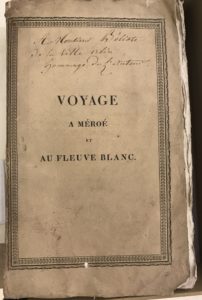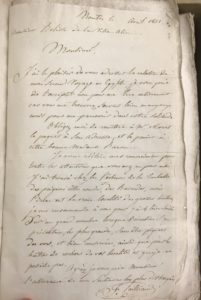Instruction in Special Collections: A Closer Look at SCRC's Recent Acquisitions
Posted on August 2, 2017
By Meghan Bryant
- Frances Lightfoot Robb Head of Special Collections Public Services & Instruction
With a goal of not only collecting and preserving texts and objects for future generations, the Special Collections Research Center is devoted to acquiring books and artifacts that can benefit instruction at William & Mary. Chinese scrolls, facsimiles of medieval texts, and a replica of Dead Sea scrolls are just a few examples of items in the SCRC that faculty have frequently used in their teaching. The SCRC recently acquired copies of two important historical texts, and Professor Jeremy Pope provides insight on how exciting and useful these works are for both faculty and student use:

These two 19th-century series that Swem has purchased both capture moments of exceptional importance in the history of Western perception of Africa, and they will be centerpieces in the upper-level lecture course that I have taught for the past eight years, “HIST 320: Nubia Americana: An African Kingdom in American Thought, 1627-present.”
The volumes published by Frédéric Cailliaud in 1826-1827 are from the infancy of European exploration into the interior of the African continent, long before the advent of scientific archaeological excavation. At that time, Western knowledge of the African past was heavily dependent upon the fragmentary testimony of ancient Greek and Roman authors who had never traveled south of Egypt—men like Herodotus, Diodorus Siculus, Strabo, and Pliny the Elder. Authors like Pliny perceived the more distant reaches of Africa as realms of monstrous abnormality, while others like Diodorus traced the roots of ancient Egyptian civilization to an even more ancient “Ethiopia”—the term Greeks used to refer to the vast territory south of Egypt, including especially the region of Sudan that scholars today call “Nubia.” Diodorus’s text was widely debated in early modern Europe and America, motivating several European explorers to lose their lives in search of Meroe, the ancient capital city of Ethiopia as recorded in Greek texts. At the end of a long and dangerous voyage in 1822, Frédéric Cailliaud became the first Westerner in modern times to visit and document the ruins of ancient Meroe, and he was so overcome with emotion that he started weeping uncontrollably at first sight of them. In the past, I have had to resign myself to merely telling my students about Cailliaud’s discovery, but thanks to Swem’s recent purchase I can now show students the artful, sepia-tone and hand-painted volumes that Cailliaud published upon his return to announce his discovery—including a rare, tipped-in letter signed in Cailliaud’s own hand!
The volumes published by Richard Lepsius in 1849-1859 cut in a very different direction. Following in the wake of explorers like Cailliaud, Lepsius organized a research expedition into Egypt and “Ethiopia” (Nubia), but unlike so many of his predecessors, Lepsius was trained in the new discipline of Egyptology and could therefore translate the ancient hieroglyphic writing inscribed upon the monuments at Meroe. As a result, he reached a very different conclusion: Lepsius claimed that Diodorus’s account had been wrong, and that the visible monuments and inscriptions in Nubia were instead the result of Egyptian culture diffusing into the south. Lepsius’s pronouncements would not be the final word on the subject, but they had a deep impact upon scholarly and public opinion for more than a century. Moreover, Lepsius’s project was generously funded by the Prussian government, so that he was able to use the new and expensive techniques of chromolithography to promote his findings in sumptuous, full-color prints and detailed maps on truly enormous folio pages. The volumes are entitled Denkmaeler aus Aegypten und Aethiopien (Monuments from Egypt and Ethiopia), but, because of their size and expense, they are equally monuments of 19th-century Prussian nationalism in a European competition for global scientific leadership. It is nearly impossible to find a complete set for purchase today, so Swem has instead acquired faithful reprints that my students will examine during the course. Instead of showing them mere PowerPoint images, I can now let the students experience the materiality of these books as monuments in their own right.



